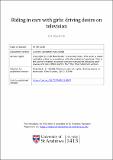Files in this item
Riding in cars with girls : driving desire on television
Item metadata
| dc.contributor.author | Shacklock, Zoë | |
| dc.date.accessioned | 2020-09-14T10:30:07Z | |
| dc.date.available | 2020-09-14T10:30:07Z | |
| dc.date.issued | 2020-08-24 | |
| dc.identifier | 270006632 | |
| dc.identifier | 9507f541-5a79-41df-82fc-fbb5f3ec1310 | |
| dc.identifier | 000562705700007 | |
| dc.identifier | 85145281640 | |
| dc.identifier.citation | Shacklock , Z 2020 , ' Riding in cars with girls : driving desire on television ' , Film Studies , vol. 21 , no. 1 , pp. 83-96 . https://doi.org/10.7227/FS.21.0007 | en |
| dc.identifier.issn | 2054-2496 | |
| dc.identifier.other | ORCID: /0000-0003-2004-0168/work/80257951 | |
| dc.identifier.uri | https://hdl.handle.net/10023/20617 | |
| dc.description.abstract | The open road is popularly imagined as both cinematic and male, a space suited to the scope afforded by the cinema and the breadth demanded by the male psyche. However, while these connotations are ingrained within the aesthetics of driving, its kinaesthetics – the articulations between bodies, movement and space – have more in common with television and with stories of women’s desire. Drawing from Iris Marion Young’s theories of gendered embodiment, this article argues that driving, television and female desire are all marked by the same contradictions between movement and stability, and between public and private. It analyses two recent television programmes concerned with women behind the wheel – Black Mirror’s ‘San Junipero’ (Netflix, 2016) and the first two seasons of Big Little Lies (HBO, 2017–present) – to argue that driving on television affords a space through which to negotiate feminine embodiment, agency and desire. | |
| dc.format.extent | 416584 | |
| dc.language.iso | eng | |
| dc.relation.ispartof | Film Studies | en |
| dc.subject | Automobility | en |
| dc.subject | Driving | en |
| dc.subject | Gender | en |
| dc.subject | Kinaesthesia | en |
| dc.subject | Television | en |
| dc.subject | Women | en |
| dc.subject | PN1993 Motion Pictures | en |
| dc.subject | H Social Sciences | en |
| dc.subject | T-NDAS | en |
| dc.subject | MCP | en |
| dc.subject.lcc | PN1993 | en |
| dc.subject.lcc | H | en |
| dc.title | Riding in cars with girls : driving desire on television | en |
| dc.type | Journal article | en |
| dc.contributor.institution | University of St Andrews. Film Studies | en |
| dc.identifier.doi | 10.7227/FS.21.0007 | |
| dc.description.status | Peer reviewed | en |
This item appears in the following Collection(s)
Items in the St Andrews Research Repository are protected by copyright, with all rights reserved, unless otherwise indicated.

